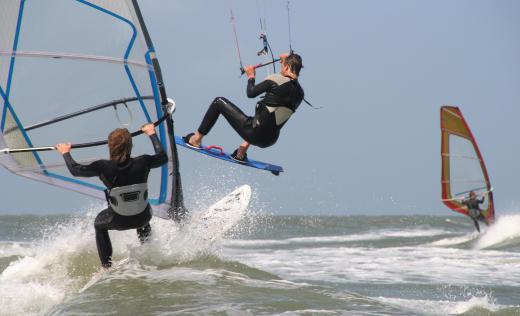Kitesurfing as a recreational sport began in the 1980s, but didn't gain popularity until the turn of the millennium. Before 2000 there were less than a thousand kite surfers worldwide. In 2005 that number had swelled to nearly 100,000. Kitesurfing is also commonly known as kiteboarding, and in some European countries as flysurfing.
The premise of kitesurfing is simple: by using a large, powerful kite for propulsion, and standing or sitting on some form of transportation, the kitesurfer is able to reach high speeds and perform amazing and exhilarating stunts. The most common form of kitesurfing is, as the name implies, done using a surfboard on a large body of water.

A form of kitesurfing known as kiteskiing is also gaining popularity, performed with either skis or a snowboard. Small buggies are also used by some kitesurfers, though the lack of mobility makes this less enticing for many kitesurfers searching for tricks. More recently some innovators have begun using power kites in tandem with what are commonly known as mountain boards. These are skateboards with large wheels for added traction, which allow very high speeds and tricks such as jumps and turns. Power kites may also be used on the water with vehicles other than a board: kayaks, canoes, and catamarans are all up to the task. Ultimately, anything which can move outdoors and needs propulsion can be teamed up with a large kite to generate the necessary power.
The kites used in kitesurfing are very large kites, referred to as power kites. They are capable of being relaunched from the water, and of sufficient surface area to generate enormous lift.
There are three main classes of power kites in common use:
- The air foil kite has no interior structure, so the airborne shape of the kite is created by the force of wind acting upon it. They launch quickly and have valves to allow air to release in case of a spill, and though they are difficult to get the hang of initially, once learned they are very easy to use.
- Inflatable kites use an inflatable edge to form the shape of the kite, keeping it in a strong crescent shape the entire time. They are very easy to launch under favorable wind conditions, though are quite difficult when there is little wind.
- Framed kites use a rigid edge of graphite or fiber glass to form the shape of the kite, and usually have very sculpted aerodynamic shapes. Again, though usually very easy to relaunch, low wind conditions make framed kites difficult to get off of the ground.

The kites used in kitesurfing are either two or four lined, either with a single control bar or with individual handles to control the lines. Initially controlling a kite can be difficult, and most beginners find even the simplest maneuvers, such as turning around, to be straining. Over time, however, an enormous amount of finesse is gained, and top kitesurfers exhibit incredible feats of control.

Kitesurfing is a difficult and relatively dangerous sport, and lessons are highly recommended for anyone looking to start out. Many people under-estimate the amount of power generated by a kite. Since a kite is moving on its own, unlike the sail of a boat, it is generating its own wind in addition to the ambient wind. One may kitesurf in winds as low as five knots, and with proper experience, may surf in winds in excess of forty knots. Winds with gusts of more than thirty knots should be considered very dangerous, however, and treated with extreme caution. People have died while kitesurfing, usually when a rogue gust propels an unwilling surfer over land and into a building or power lines; though kitesurfers have also been blown out to sea to drown.
A new kitesurfing kit can be gotten for $1,000-$2,500 (US dollars), though given the difficulty of the sport, good deals on used equipment are quite common. Lessons range from $200-$500 for a two to three hour session, and usually a few lessons are required before sufficient competence is achieved to begin surfing on one's own. For some people, fairly complex maneuvers such as jumping waves and turning while moving can be attained within ten to twenty hours on the water.
With the rising popularity of kitesurfing, most major seaside cities offer classes and have kitesurfing clubs, and many tropical destinations are following suit. For an able, strong person with the right dedication, kitesurfing can prove to be a very fun, incredibly exciting sport, with no limit to the complexity of tricks and new moves one can discover.
